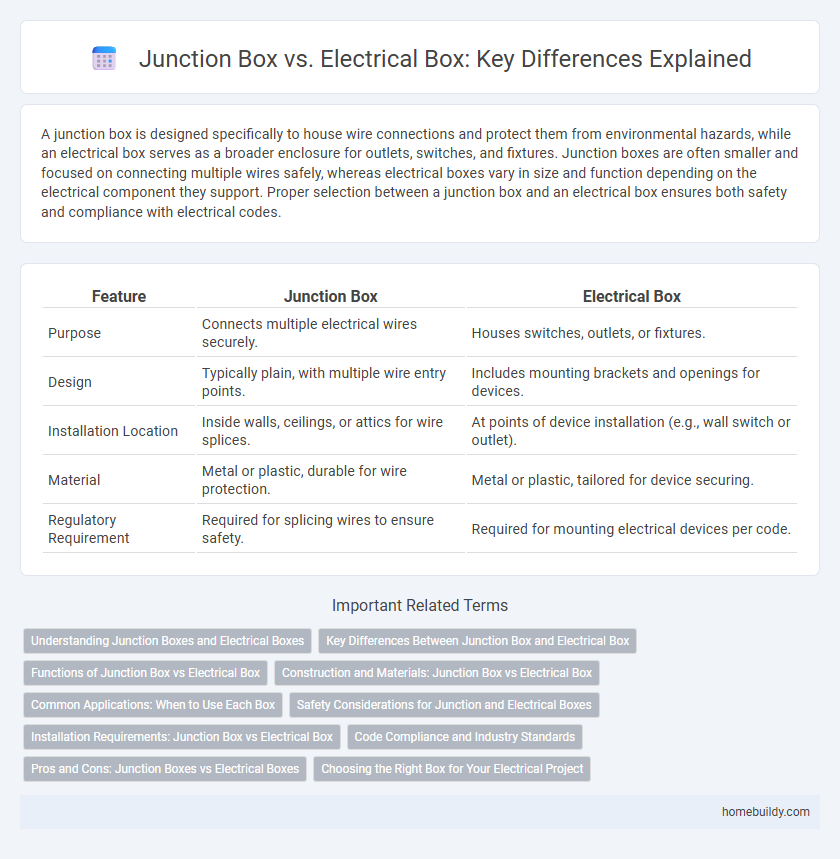A junction box is designed specifically to house wire connections and protect them from environmental hazards, while an electrical box serves as a broader enclosure for outlets, switches, and fixtures. Junction boxes are often smaller and focused on connecting multiple wires safely, whereas electrical boxes vary in size and function depending on the electrical component they support. Proper selection between a junction box and an electrical box ensures both safety and compliance with electrical codes.
Table of Comparison
| Feature | Junction Box | Electrical Box |
|---|---|---|
| Purpose | Connects multiple electrical wires securely. | Houses switches, outlets, or fixtures. |
| Design | Typically plain, with multiple wire entry points. | Includes mounting brackets and openings for devices. |
| Installation Location | Inside walls, ceilings, or attics for wire splices. | At points of device installation (e.g., wall switch or outlet). |
| Material | Metal or plastic, durable for wire protection. | Metal or plastic, tailored for device securing. |
| Regulatory Requirement | Required for splicing wires to ensure safety. | Required for mounting electrical devices per code. |
Understanding Junction Boxes and Electrical Boxes
Junction boxes serve as protective enclosures for electrical connections, ensuring safe wire splicing and preventing accidental contact, while electrical boxes encompass a broader category that includes outlets, switches, and fixture boxes. Understanding the distinction is crucial for proper electrical system design, as junction boxes primarily facilitate wire joining without device mounting, unlike some electrical boxes that support hardware installation. Compliance with NEC (National Electrical Code) standards emphasizes the strategic use of junction boxes to maintain circuit integrity and enhance safety.
Key Differences Between Junction Box and Electrical Box
A junction box primarily serves as a protective enclosure for electrical connections, while an electrical box encompasses a broader range of applications, including housing switches, outlets, and light fixtures. Junction boxes are typically used to join wiring safely and facilitate circuit branching without devices, whereas electrical boxes provide mounting and support for electrical devices. Key differences include their specific functions, design variations, and code requirements for installation and accessibility.
Functions of Junction Box vs Electrical Box
Junction boxes serve as secure enclosures where multiple electrical wires connect, providing a safe space for splicing and protecting connections from damage or environmental elements. Electrical boxes, which include outlet, switch, and fixture boxes, primarily house devices and manage wiring connections while supporting structural installation and accessibility for maintenance. The distinct function of a junction box lies in consolidating numerous wire splices, whereas electrical boxes focus on device mounting and providing access points in the electrical system.
Construction and Materials: Junction Box vs Electrical Box
Junction boxes are typically constructed from durable, non-combustible materials like metal or heavy-duty plastic to safely house wire connections and prevent electrical hazards. Electrical boxes, while also made from metal or plastic, vary more in size and shape to accommodate switches, outlets, and fixtures, tailored specifically for mounting and securing hardware. The distinct materials and construction methods of junction boxes prioritize wire protection and accessibility, whereas electrical boxes emphasize functionality for device installation within building wiring systems.
Common Applications: When to Use Each Box
Junction boxes are primarily used to house and protect wire connections in residential and commercial electrical systems, ensuring safety and accessibility for future maintenance. Electrical boxes serve multiple functions such as mounting switches, outlets, and fixtures, making them essential for device installation and wiring terminations. Choosing between a junction box and an electrical box depends on whether the focus is on wire splicing or device mounting in various electrical setups.
Safety Considerations for Junction and Electrical Boxes
Junction boxes provide a sealed enclosure that prevents accidental contact with live wires and shields connections from moisture and dust, enhancing electrical safety. Electrical boxes, while also protecting wiring, vary in design and installation methods that affect their effectiveness in containing sparks and heat during faults. Properly rated junction and electrical boxes with secure covers reduce fire hazards and ensure compliance with NEC standards, minimizing the risk of electrical shock and short circuits.
Installation Requirements: Junction Box vs Electrical Box
Installation requirements for junction boxes typically demand secure mounting within walls or ceilings with accessible covers for future wiring changes, ensuring compliance with NEC standards for wire splicing and protection. Electrical boxes, while similar, must be sized appropriately to accommodate switches, outlets, and wiring devices, adhering to specific box fill calculations to prevent overcrowding and potential hazards. Both types require grounding and proper cable clamps to maintain electrical safety and system integrity.
Code Compliance and Industry Standards
Junction boxes and electrical boxes must comply with NEC (National Electrical Code) standards to ensure safety and functionality in wiring systems. Junction boxes are specifically designed to house and protect wire connections and must be accessible for inspection and maintenance, adhering to NEC Article 314 requirements. Electrical boxes, including junction boxes, must meet UL (Underwriters Laboratories) listings and local code regulations to guarantee proper installation and fire resistance.
Pros and Cons: Junction Boxes vs Electrical Boxes
Junction boxes offer superior protection and organization for wiring connections, preventing electrical hazards and simplifying maintenance with easy access points. Electrical boxes come in various forms tailored to housing switches, outlets, or fixtures but may lack the comprehensive wiring management features of junction boxes. The choice depends on specific needs: junction boxes excel in complex wiring networks, while electrical boxes are optimal for device installation with straightforward wiring.
Choosing the Right Box for Your Electrical Project
Choosing the right box for your electrical project depends on the specific application and installation requirements. Junction boxes are designed to safely enclose wire connections and splices, offering easy access for maintenance, while electrical boxes include a broader range of types such as outlet, switch, and ceiling boxes tailored for mounting fixtures and devices. Evaluating box size, wall type compatibility, and electrical code compliance ensures the selection of the most effective enclosure for both safety and functionality.
Junction box vs Electrical box Infographic

 homebuildy.com
homebuildy.com